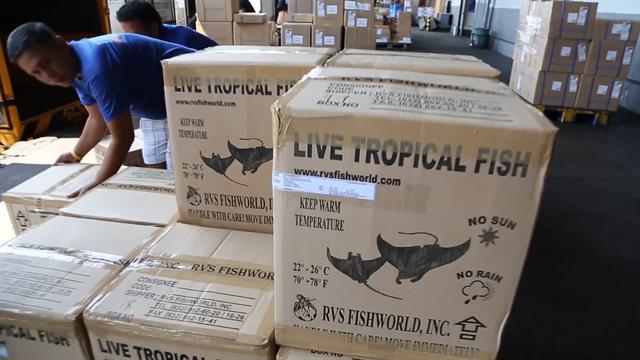
Even if you’ve never owned a saltwater aquarium, it’s likely you’ve come across one before—perhaps at a restaurant or in your friend’s living room—with corals aglow and flamboyant fish flitting around them in trance-inducing patterns.
Marine aquariums are a multimillion-dollar a year business and an obsession for many people. Each year about 10 million tropical fish are imported into the U.S., more than to any other country. At least a million households have saltwater aquariums, a 2014 survey by the American Pet Products Association found.
Blue tang is a popular species in the saltwater aquarium trade, a multimillion-dollar industry involving approximately 2,000 types of tropical fish.
Photograph by Mikayla Wujec
Breeders have managed to raise a small number of saltwater species, such as the popular orange-and-white-striped clownfish and the yellow tang. But captive breeding doesn’t nearly satisfy the demand, and the vast majority of the estimated 2,000 species involved in the trade are captured from coral reef habitats in nearly 40 countries, although most come from the Philippines and Indonesia.
Despite its profitability and global reach, the saltwater aquarium industry is largely undocumented. No centralized database tracks how many fish are taken from reefs, for instance, and little information exists about how the capture of fish—sometimes by the destructive use of cyanide and dynamite—affects their numbers in the wild.
As for details about key aquarium fish traders and routes that fish take from origin to destination—that’s largely unexplored territory as well.
The murky nature of the industry spurred a group of four National Geographic explorers to action. “We started thinking about fish and how they’re traded, and we realized we hadn’t heard much about the marine aquarium trade,” said Mikayla Wujec, who has a background in marine conservation. “We all kind of put our heads together and said, ‘Hey, we wish we knew more about this.’”
Armed with a $25,000 grant from National Geographic Society, in 2015 the group—led by Shannon Switzer Swanson, a marine social ecologist and Ph.D. student at Stanford University—traveled to Southeast Asia and around the U.S., interviewing everyone from fishermen in Indonesia to aquarium hobbyists in Colorado in an effort to trace the supply chain of tropical fish and identify ways to lessen the trade’s harmful effects. (The team paid special attention to the capture and transport of blue tang, a species popularized by the hit film Finding Nemo and its sequel, Finding Dory, the release of which coincided with their work.)
They documented the capture, sale, export, import, and display of tank-bound fish through photographs, seen below.
“This is the first project that synthesizes the journey of the aquatic trade,” said team member Andrea Reid, a fish biologist and Ph.D. student at Carleton University and the University of British Columbia.
Added Swanson: “We were really trying to bring that story to life.”
Bagikan Berita Ini














0 Response to "See How Fish Get From Coral Reefs to Your Aquarium Tank"
Post a Comment